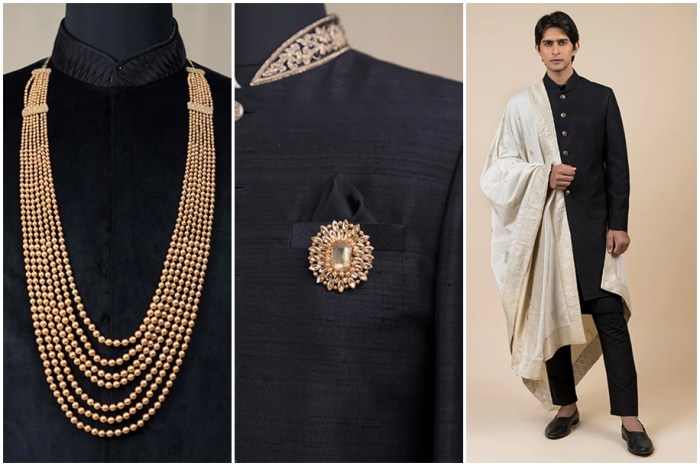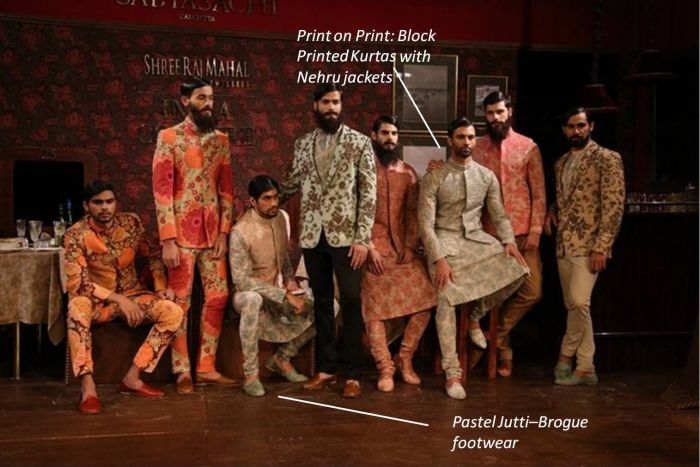Mens Wedding Dress in India A Style Guide
Traditional Indian Wedding Attire for Men
Men’s wedding dress in india – Men’s wedding attire in India boasts a rich tapestry of traditions, varying significantly across regions and religions. The evolution of these styles reflects changing social norms, economic influences, and the blending of cultural elements. This section will explore the historical development, symbolic meanings, and stylistic distinctions of traditional Indian menswear for weddings.
Evolution of Men’s Wedding Attire in India
Historically, men’s wedding attire reflected regional and religious customs. In North India, the sherwani, a long coat, emerged as a prominent choice, often paired with churidar pajamas. South India saw the prevalence of dhotis and veshtis, often intricately woven and adorned. The Mughal influence significantly impacted the designs, introducing rich embroidery and embellishments. Over time, Western influences led to the adoption of elements like tailored suits, though traditional attire remains dominant in many communities.
Significance of Colors and Fabrics
Color and fabric choices hold deep cultural significance. Rich colors like red, gold, and maroon symbolize auspiciousness and prosperity. Silk, brocade, and velvet are frequently used for their luxurious texture and visual appeal. The choice of fabric and color can also vary based on regional preferences and religious customs. For instance, lighter colors might be preferred in warmer climates, while darker, richer tones are more common in cooler regions.
Comparison of Sherwanis, Achkans, and Kurta-Pyjamas
Three prominent styles of traditional Indian menswear are the sherwani, achkan, and kurta-pyjama. Each possesses distinct features and regional variations.
| Outfit Name | Fabric | Common Embellishments | Regional Variations |
|---|---|---|---|
| Sherwani | Silk, brocade, velvet | Embroidery, Zardozi work, sequins | Length, sleeve style vary regionally; longer and more ornate in some areas. |
| Achkan | Silk, brocade, cotton | Embroidery, buttons, minimal embellishments | Often more fitted than a sherwani; variations in collar and button styles. |
| Kurta-Pyjama | Cotton, silk, linen | Embroidery, minimal embellishments, simple buttons | Length and fit vary widely; can be simple or richly decorated. |
Modern Interpretations of Men’s Wedding Dresses in India
Contemporary Indian men’s wedding fashion demonstrates a fascinating blend of tradition and modernity. Western influences have subtly reshaped styles, while the enduring appeal of traditional elements remains strong. This section explores the integration of modern aesthetics and the rise of unconventional choices.
Influence of Western Fashion
Western fashion has impacted Indian menswear, introducing elements like slimmer fits, structured silhouettes, and the use of Western fabrics such as linen and wool in fusion designs. This is especially evident in Indo-Western fusion outfits, a popular choice for grooms who want a contemporary look with a touch of tradition.
Indian men’s wedding attire is famously diverse, ranging from sherwanis to bandhgalas. The overall aesthetic often influences the guest attire, with many women choosing equally sophisticated looks. For female guests seeking an elegant option, consider the beautiful selection of maxi elegant dresses for wedding guests available online. The vibrant colors and rich fabrics of the men’s clothing often complement these stylish maxi dresses, creating a harmonious and visually stunning wedding celebration.
Popularity of Indo-Western Fusion Outfits
Indo-Western fusion outfits represent a significant trend. These designs creatively combine traditional Indian elements (like embroidery or fabrics) with Western tailoring techniques and silhouettes (such as bandhgala jackets paired with trousers). This allows grooms to express their individuality while honoring their heritage. Examples include a bandhgala jacket in silk with tailored trousers or a sherwani with a modern twist in its cut and color palette.
Modern Twists on Traditional Menswear

Source: weddingsutra.com
Modern interpretations often involve updating traditional garments with contemporary fabrics, colors, and styling. For instance, sherwanis might be made from lighter fabrics like linen or silk blends for a more comfortable and modern feel. Unconventional color palettes, such as deep blues, greens, or even muted pastels, are gaining popularity, offering a refreshing alternative to traditional reds and golds.
Modern styling might involve pairing a sherwani with slim-fit trousers or a Nehru jacket with a dhoti for a unique look.
The Role of Designers and Trends
Leading Indian designers play a crucial role in shaping men’s wedding fashion trends, introducing innovative designs and reinterpreting traditional styles. This section will highlight prominent designers and current trends.
Prominent Indian Designers
Many renowned Indian designers, such as Tarun Tahiliani, Rohit Bal, and Manish Malhotra, are known for their exquisite men’s wedding collections. They often incorporate intricate embroidery, luxurious fabrics, and unique silhouettes, setting trends in the industry. Their work often blends traditional craftsmanship with modern design sensibilities.
Current Trends in Men’s Wedding Fashion
Current trends include a preference for lighter, more breathable fabrics, especially in warmer climates. Embellishments are often more subtle and sophisticated, with a focus on clean lines and tailored fits. Pastel shades, jewel tones, and metallic accents are popular color choices. Experimentation with different silhouettes, such as asymmetric cuts or layered designs, is also evident.
Hypothetical Men’s Wedding Outfit

Source: squarespace-cdn.com
A hypothetical modern yet traditional outfit might consist of a cream-colored silk sherwani with subtle gold embroidery on the collar and cuffs. The sherwani would have a slim, contemporary fit. It would be paired with ivory churidar pajamas and embellished leather Jodhpuri shoes. A silk dupatta in a complementary shade could be draped over the shoulder. This outfit balances tradition with a modern sensibility.
Accessorizing Men’s Wedding Attire in India
Accessories play a vital role in completing the look of an Indian groom’s wedding attire. These additions add a personal touch and often carry cultural significance. This section will explore common accessories and their importance.
Common Accessories
Common accessories include turbans (safa or pagdi), which vary greatly in style and color depending on the region and community; jewelry, such as necklaces, bracelets, and rings; and footwear, such as mojaris (traditional shoes) or Jodhpuri shoes. The use of a safa is particularly significant in some communities, symbolizing status and honor.
Cultural Significance of Accessories
Many accessories hold symbolic meaning. For example, certain types of jewelry might be associated with specific gods or deities, while the color and style of a turban can indicate regional identity or family lineage. The choice of accessories reflects personal style and cultural heritage.
Visual Description of a Complete Wedding Outfit (Rajasthan)
A complete Rajasthani wedding outfit might include a vibrant red and gold bandhani sherwani with intricate mirror work, paired with cream-colored churidar pajamas. A matching safa, adorned with a kalgi (a plume or ornament), would be worn on the head. Heavy gold jewelry, including a necklace, bangles, and a ring, would complement the outfit. Embroidered mojaris would complete the look, showcasing a rich blend of traditional Rajasthani craftsmanship and festive colors.
The Cost and Availability of Men’s Wedding Attire: Men’s Wedding Dress In India
The cost and availability of men’s wedding attire in India vary widely depending on the type of outfit, fabric, embellishments, and the designer. This section provides an overview of pricing and purchasing options.
Price Range
The price range can span from a few thousand rupees for simpler kurta-pyjamas to several lakhs of rupees for intricately embroidered designer sherwanis. The cost is significantly influenced by the fabric, the level of embellishment, and the brand or designer.
Bespoke Tailoring vs. Ready-to-Wear
Bespoke tailoring offers a personalized fit and the opportunity to create a truly unique outfit, but it is generally more expensive than ready-to-wear options. Ready-to-wear provides convenience and a wider range of choices, although the fit may not be as perfect.
Places to Find Wedding Attire

Source: wedmegood.com
Men can find wedding attire in a variety of places, including specialized boutiques, large department stores, online retailers, and independent tailors. Online retailers offer a wide selection and convenience, while boutiques and tailors provide a more personalized experience.
Regional Variations in Men’s Wedding Attire
Significant variations exist in men’s wedding attire across different regions of India. These differences reflect the diverse cultural heritage and traditions of the country. This section explores these regional distinctions.
Regional Styles and Traditions
North Indian weddings often feature sherwanis and achkans, while South Indian weddings might showcase dhotis and veshtis. Western India might incorporate elements of both styles, reflecting the region’s diverse cultural influences. Eastern India also has its unique styles, often featuring simpler, more understated designs.
Differences in Fabrics, Colors, and Embellishments, Men’s wedding dress in india
- North India: Rich brocades, silks, heavy embroidery (Zardozi, Resham), vibrant colors like red, gold, maroon.
- South India: Silk, cotton, intricate weaving techniques (Kanjeevaram silk), lighter colors, simpler embellishments.
- West India: Blend of North and South Indian styles, use of bandhani (tie-dye) and mirror work, a wider range of colors.
- East India: Lighter fabrics, simpler designs, muted colors, often incorporating local weaving techniques.
Question & Answer Hub
What is the average time needed for bespoke tailoring?
Bespoke tailoring typically requires 4-8 weeks, depending on the complexity of the design and the tailor’s workload.
Are there rental options for wedding attire?
Yes, many boutiques and online retailers offer rental services for men’s wedding attire, providing a cost-effective alternative to purchasing.
How should I care for my wedding outfit after the ceremony?
Dry cleaning is recommended for most traditional Indian wedding attire to preserve its condition and embellishments. Follow the specific care instructions provided by the retailer or tailor.



















